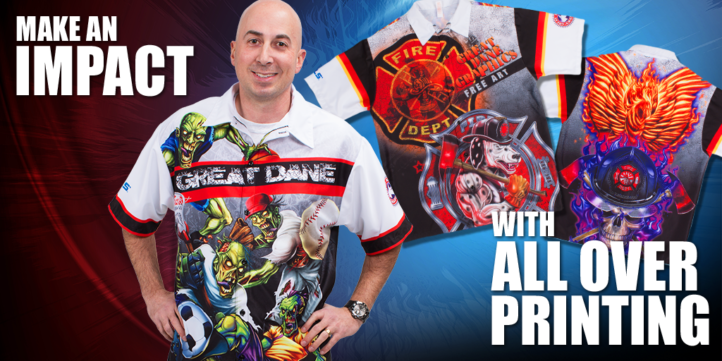No products in the cart.

- admin
-
A Look at All Over Printing
All over printing is a great way to increase impact and impress your customers.
While it’s a lesser-known technique, it’s unique and sets your shop apart from the rest. It does require investing in an oversize heat press, but this can easily be farmed out on a contract basis until your own volume is high enough to justify the expense.
All over printing is just what its name implies: printing an image or images to completely cover a garment seam to seam. This effect grabs attention and has real appeal in certain markets, provided it’s done right. To be successful, it requires a good sense of design, as well as an understanding of the techniques involved.
There are two approaches to this type of decorating: sublimating a finished garment, or sublimating cut pieces of fabric before they are sewn. Although direct screen printing can be used, it requires oversized screens, which means having oversized exposure units and washout sinks, etc. For this reason, most providers use sublimation transfers.
Advantages of All Over Sublimation Printing
The biggest advantage to oversize sublimation printing is its soft hand and vivid colors. It eliminates having to squeegee over collars, buttons, plackets, and pockets, as you’d have to do if you were screen printing. This enhances the all over effect by allowing for more uniform, consistent printing. The only limitation with sublimation is it can be done only on fabrics with a polyester content—the higher, the better—and white or light colors because the inks are translucent.
Creating The Big Picture

Example of all over printing with dye-sublimation. Good all over printing starts with the design. As with any apparel graphic, it’s important to take into account both the garment and its intended market. For all over applications, you want to create a look that takes advantage of the format and adds to its appeal.
Typically for finished shirts, you’re going to need a front and back design and one for each sleeve. While you can create your own art, there’s a wide variety of clip art options to choose from that can easily be adapted for this purpose.
Once you’ve chosen a theme or direction, the trick is tailoring the design for application, which begins with creating a garment template. You can do this by laying the shirt flat, taking its measurements, and drawing it in Adobe® Illustrator® software. For best results, a template has to be made for each size and/or brand.
Simply scaling the design up or down proportionally doesn’t work well because of differences in the way the material lays in different sizes. Similarly, although you can design for the main image area on the smallest size and then add filler art on larger garments, it’s going to skew the proportions and not look quite right.
The next step is to import the template into Photoshop® software. I personally use Photoshop® software, but you also can use Abobe® Illustrator® software or CorelDRAW® software. Bring the individual designs into the design software program and try them in various sizes and arrangements. You can position elements to tell a story; change the colors and the degree of saturation; rotate, flip and overlap them; push some parts of the design forward; and make others less prominent.
This is how you’ll see what works and what doesn’t. A lot of times, you’ll encounter issues with the shape of the image or striking a balance between an image being big and bold vs. overpowering. Sometimes, if there are too many small elements, the design doesn’t have a focus or it looks busy and out of control.
Designing for all over printing is not a fast process. For one thing, these are high-res, large—sometimes 900 MB to 1 GB—files with multiple layers. That slows down designing; so count on about three or four hours of time. The main thing is that it’s not just about the artwork, it’s about moving things around and coming up with a layout that’s pleasing and works.
Photographed: Zombie Sublimated Shirt
Front: Zombie Basketball, D-3581; Zombie Baseball D-3582; Zombie Lacrosse, D-3583; Zombie Soccer Kick, C-3521
Back: Zombie Grave, C-3561
Photographed: Firefighter Sublimated Shirt
Front: Fireman Maltese Emblem, D-3982; Firefighter Dalmatian, D-4114


Leave a Reply
You must be logged in to post a comment.